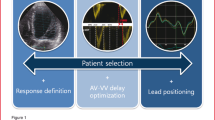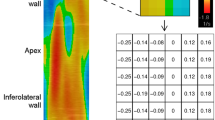Abstract
Recent literature indicates that torsion of the left ventricle (LV) is a promising predictor for response to cardiac resynchronisation therapy (CRT). Among patients with severe heart failure, 45 to 75% of patients show rigid body rotation, where the base and apex rotate in the same direction, instead of normal, opposite rotation. The occurrence of this phenomenon seems to be a good indicator for response to CRT. From this review, it can be concluded that LV torsion might be a welcome addition to current selection criteria.



Similar content being viewed by others
References
Cleland JGF, Daubert JC, Erdmann E, et al. The effect of cardiac resynchronization therapy on morbidity and mortality in heart failure. N Engl J Med. 2005;352:1539–49.
Bleeker GB, Bax JJ, Fung JWH, et al. Clinical versus echocardiographic parameters to assess response to cardiac resynchronization therapy. Am J Cardiol. 2006;97:260–3.
Strickberger SA, Conti J, Daoud EG, et al. Patient selection for cardiac resynchronization therapy. Circ. 2005;111:2760–7.
Chung ES, Leon AR, Tavazzi L, et al. Results of the predictors of response to CRT (PROSPECT) trial. Circ. 2008;117:2608–16.
Rüssel IK, Zwanenburg JJM, Germans T, et al. Mechanical dyssynchrony or myocardial shortening as MRI predictor of response to biventricular pacing? J Magn Res Imaging. 2007;26:1452–60.
Carasso S, Rakowski H, Witte KK, et al. Left Ventricular strain patterns in dilated cardiomyopathy predict response to cardiac resynchronization therapy: timing is not everything. J Am Soc Echocardiogr. 2009;22:242–50.
Helm RH, Leclercq C, Faris OP, et al. Cardiac dyssynchrony analysis using circumferential versus longitudinal strain: implications for assessing cardiac resynchronization. Circ. 2005;111:2760–7.
Bilchick KC, Dimaano V, Wu KC, et al. Cardiac magnetic resonance assessment of dyssynchrony and myocardial scar predicts function class improvement following cardiac resynchronization therapy. JACC Cardiovasc Imaging. 2008;1:561–8.
Lorenz CH, Pastorek JS, Bundy JM. Delineation of normal human left ventricular twist throughout systole by tagged magnetic resonance imaging. J Cardiovasc Magn Reson. 2000;2:97–108.
Arts T, Reneman RS, Veenstra PC. A model of the mechanics of the left ventricle. Ann Biomed Eng. 1979;7:299–318.
Notomi Y, Popovic ZB, Yamada H, et al. Ventricular untwisting: a temporal link between left ventricular relaxation and suction. Am J Physiol Heart Circ Physiol. 2008;294:H505–13.
Axel L, Dougherty L. MR imaging of motion with spatial modulation of magnetization. Radiology. 1989;171:841–5.
Helle-Valle T, Crosby J, Edvardsen T, et al. New noninvasive method for assessment of left ventricular rotation: speckle tracking echocardiography. Circ. 2005;112:3149–456.
Rüssel IK, Götte MJW, Bronzwaer JG, et al. Left ventricular torsion: an expanding role in the analysis of myocardial function. JACC Cardiovasc Imaging. 2009;2:648–55.
Hansen DE, Daughters GT, Alderman EL, et al. Effect of acute cardiac allograft rejection on left ventricular systolic torsion and diastolic recoil measured by intramyocardial markers. Circ. 1987;76:988–1008.
Young AA, Dokos S, Powell KA, et al. Regional heterogeneity of function in nonischemic dilated cardiomyopathy. Cardiovasc Res. 2001;49:308–18.
Nagel E, Stuber M, Lakatos M, et al. Cardiac rotation and relaxation after anterolateral myocardial infarction. Coron Artery Dis. 2000;11:261–7.
Setser RM, Kasper JM, Lieber ML, et al. Persistent abnormal left ventricular systolic torsion in dilated cardiomyopathy after partial left ventriculectomy. J Thorac Cardiovasc Surg. 2003;126:48–55.
Kanzaki H, Nakatani S, Yamada N, et al. Impaired systolic torsion in dilated cardiomyopathy: reversal of apical rotation at mid-systole characterized with magnetic resonance tagging method. Basic Res Cardiol. 2006;101:465–70.
Popescu BA, Beladan CC, Calin A, et al. Left ventricular remodeling and torsional dynamics in dilated cardiomyopathy: reversed apical rotation as a marker of disease severity. Eur J Heart Fail. 2009;11:945–51.
Van Dalen BM, Caliskan K, Soliman OII, et al. Left ventricular solid body rotation in non-compaction cardiomyopathy: a potential new objective and quantitative functional diagnostic criterion? Eur J Heart Fail. 2008;10:1088–93.
Sade LE, Demir O, Atar I, et al. Effect of mechanical dyssynchrony and cardiac resynchronization therapy on left ventricular rotational mechanics. Am J Cardiol. 2008;101:1163–9.
Rüssel IK, Götte MJW, De Roest GJ, et al. Loss of opposite left ventricular basal and apical rotation predicts acute response to cardiac resynchronization therapy and is associated with long-term reversed remodeling. J Card Fail. 2009;15:717–25.
Bertini M, Marsan A, Delgado V, et al. Effects of cardiac resynchronization therapy on left ventricular twist. J Am Coll Cardiol. 2009;54:1317–25.
Zhang Q, Fung JW, Yip GW, et al. Improvement of left ventricular myocardial short-axis, but not long-axis function or torsion after cardiac resynchronization therapy: an assessment by two-dimensional speckle tracking. Heart. 2008;94:1464–71.
Ashikaga H, Leclercq C, Wang J, Kass DA, McVeigh ER. Hemodynamic improvement in cardiac resynchronization does not require improvement in left ventricular rotation mechanics: three-dimensional tagged MRI analysis. Circ Cardiovasc Imaging. 2010, May 17 (epub ahead of print).
Author information
Authors and Affiliations
Corresponding author
Rights and permissions
About this article
Cite this article
Rüssel, I.K., Götte, M.J.W. New insights in LV torsion for the selection of cardiac resynchronisation therapy candidates. Neth Heart J 19, 386–391 (2011). https://doi.org/10.1007/s12471-011-0136-y
Published:
Issue Date:
DOI: https://doi.org/10.1007/s12471-011-0136-y




